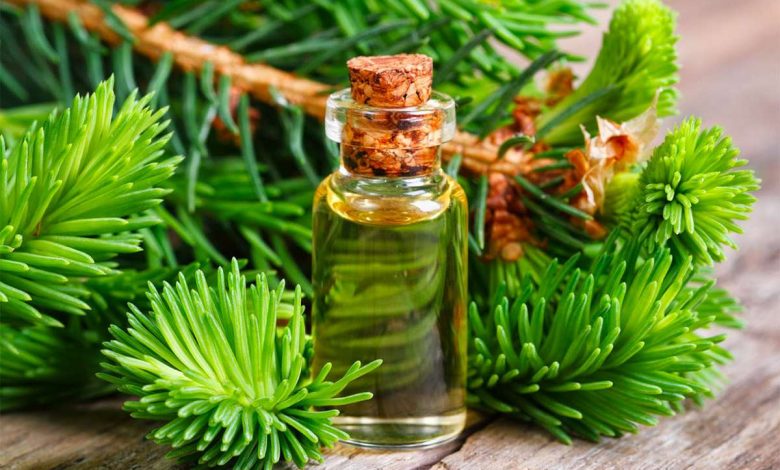Fir oil: properties, benefit and harm, what heals, application recipes

Fir oil – it is a universal healer for many incipient diseases. No wonder they say, that “it is better to prevent the disease, how to treat it".
How to make fir oil?
Fir oil is obtained by steam processing needles and young shoots. (oil output only approx. 1%). It is carried out in Europe and Asia, primarily, in Eastern Siberia (Tuva, Khakassia, Altai Territory), Crimea, in ecologically clean places. Canadian (North America) and white fir (Western Europe)
The chemical composition of fir oil
The composition of fir oil is presented, primarily, monoterpene hydrocarbons and bornyl acetate. The main essential component of Siberian fir oil is bornyl acetate. (about 30-40%), which is an ester of borneol and acetic acid. It is used for inhalation, perfumery and household chemicals.
Fir oil also contains many useful elements., eg, tannins, having the property of creating insoluble molecular bonds with salts of alkaloids and heavy metals, followed by their removal from the body..
There is a supply of carotene. which creates an antioxidant effect, protects cell membranes from destruction by free radicals. Lots of ascorbic acid, vitamin E and others. The usefulness of which everyone knows.
Properties of fir oil
Fir oil is a colorless or slightly colored liquid with a pleasant characteristic smell of needles.. Fir oil is highly soluble in ethanol (ie. in alcoholic liquids) and vegetable oils; bad - in glycerin and almost completely insoluble in water. It should be noted, that it is a fire hazard (flash point - 59º C).
Fir oil has various medicinal properties.: antiviral, anti-inflammatory, analgesic, tonic, expectorant, soothing, regenerating, bactericidal and other qualities.
How to apply fir oil?
Since ancient times, people have learned to use fir oil at home., as a powerful remedy with a high biological value of the components.
When ingesting fir oil, it is very important to remember, that it does not decompose in the stomach, and immediately penetrates into the blood, which allows you to extinguish the inflammatory process already at the initial stage.
Fir oil is used to treat many colds. (flu, bronchitis, pneumonia), as well as liver diseases, kidney, gastrointestinal tract.
Fir oil is a source of vitamins, increases efficiency, boosts the body's immune system, rids the body of harmful substances, normalizes blood pressure, helps with chronic fatigue syndrome, accompanied by a lack of vitality and insomnia.
The external method of applying the oil allows you to cure abrasions and cuts, destroy foci of suppuration due to its powerful disinfectant action. It has been successfully used for bruises., radicals, arthritis, the polyarthritis. The oil is also used as an adjuvant therapy in the treatment of female and male diseases of the genital area., herpes, eczema, psoriaze, burns, the gymors, foot fungus, etc..
Fir oil is also successfully used in cosmetology.. Its rich composition has so many medicinal properties, that when it is used in a person, the condition of the hair improves, face and body skin. Add a few drops of oil to creams, balms, ointment, Gels, shampoos, etc..
Besides, healing (antiviral) oil vapors are used in influenza epidemics, in aromatherapy and as a simple room fragrance.
The use of fir oil for colds and other diseases

If you feel, that hypothermia. you can take a bath, by adding fir oil to the water (a few drops). Water should be no more 40 degrees, otherwise the effect will not be pronounced, since the fatty components of the oil will not be able to create a uniform film on the water.
You should stay in the bath for no more than 20 minutes. A slight tingling of the skin is considered normal.. After taking a bath, rub well with a towel., put on warm socks, drink medicinal tea and go to bed in a warm bed. Much easier in the morning.
When coughing. arising, due to colds and flu, you can immediately use spruce oil as a therapeutic inhalation or drip 3-5 drops on the basis of speech (2 once a day).
For colds, it is also recommended to rub the oil in the chest area., collar part of the back, feet, then wrap the rubbing areas with compressor paper and wrap the patient with a blanket (to 4 once a day). To enhance the effect, you can drip one drop of vegetable oil also into the nose..
To normalize blood pressure, you need to start taking with two drops of oil (maybe with a little honey), gradually increasing to 10 drops 3 once a day. Course of treatment 30–40 days. To maintain a normal level of pressure, it is recommended, after consulting a doctor, to switch to a single oil intake. (once a day with a break of two weeks once every two months).
When herpes vata, soaked in spruce oil, apply on 15-20 minutes to the sore spot (2-3 once a day).
With a fungus on the legs, you need to make lotions with spruce oil on 20-30 minutes.
Contraindications of fir oil
I would like to remind you again, that before using any natural product as a treatment, you should consult a doctor to identify allergies to some components, and also there is an individual intolerance.
The oil should not be used orally during the acute stage of kidney disease., with a stomach ulcer, etc..
Due to the possibility of destruction of tooth enamel, direct contact with the oil on the teeth should be avoided..
When combining the use of fir oil with alcohol, unpleasant reactions and lack of a therapeutic effect may occur..
A clear contraindication to the use of fir preparations is pregnancy and lactation., as there is a danger of allergies.
